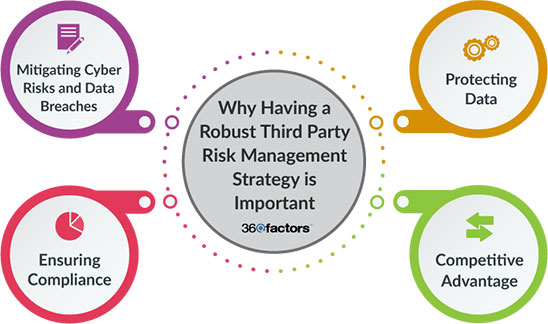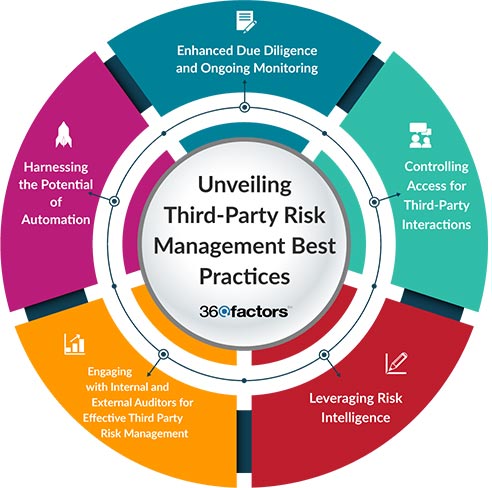Home/ Blog / Third-Party Risk Management Best Practices for Financial Enterprises
Third-party products and services have become integral to operations in the dynamic and interconnected world of financial services, bringing both opportunities and risks. Vendors, suppliers, and third-party service providers can help enterprises enhance service delivery, streamline processes, and gain competitive advantages. However, they also introduce risks that, if not effectively managed, can lead to monetary loss, regulatory penalties, reputational damage, and even operational failure.
As an executive or a risk and compliance professional in the financial sector, one of your key responsibilities is mitigating third-party risks and implementing third-party risk management best practices. This role has become increasingly complex and essential in an era of growing regulatory pressures, advanced cyber threats, and heightened customer expectations around security and privacy.
Robust Third-Party Risk Management (TPRM) strategies are vital to address these concerns effectively. These practices should prioritize risk identification, mitigation, and leveraging these relationships to drive strategic growth.
This blog will explore third-party risk management best practices, guiding leaders like you as you navigate the intricate landscape of third-party relationships in the financial sector. These insights aim to strengthen your organization’s third-party risk management framework, enhance overall resilience, and ensure compliance and competitive advantage in today’s evolving marketplace.
The Implications of Third-Party Risks on Financial Enterprises
In the fast-paced commercial climate of today, outsourcing work and third-party service providers are ubiquitous. While they undoubtedly confer benefits regarding operational efficiency and cost savings, they also expose organizations to significant risks – particularly in data security. The implications of a third-party breach can be profoundly disruptive and costly for businesses. Such violations can lead to the failure of internal controls, operational disruptions, as well as internal and external outages. More severe cases can result in lawsuits, hefty regulatory fines, and a damaging loss of trust among customers and employees. The impact can be especially severe for financial enterprises, where data integrity and customer trust are paramount. Here, third-party risk management best practices are essential because such organizations deal with large volumes of sensitive personal and financial data, making them lucrative targets for cybercriminals. A successful attack could result in monetary loss and the violation of stringent industry regulations. Given these significant potential risks, implementing a robust third-party risk management framework is no longer optional for financial enterprises but an absolute necessity.Why Having a Robust TPRM Strategy is Important

Protecting Data
A financial enterprise’s core lies in the data it processes, from sensitive customer information to critical operational metrics. A robust TPRM strategy ensures that third-party vendors view this data responsibly and securely, protecting it from unauthorized access or manipulation.Competitive Advantage
A comprehensive TPRM strategy does more than just protect your business—it can also give you a competitive edge. By demonstrating compliance with industry regulations, your organization is committed to data security and privacy. A robust strategy with third-party risk management best practices helps avoid potential regulatory penalties and builds trust with customers and partners.Ensuring Compliance
Compliance is more crucial than ever, with the regulatory landscape becoming increasingly stringent. An effective TPRM strategy can help ensure adherence to industry-relevant regulations, thereby avoiding costly fines and reputational harm.Unveiling Third-Party Risk Management Best Practices
The interconnectivity of today’s financial enterprises necessitates strong measures for third-party risk management platforms. Unfortunately, many companies only identify risks after onboarding vendors, which is often too late to prevent potential damage. Here are some best practices to help your organization establish a robust and proactive Third-Party Risk Management (TPRM) strategy:
Enhanced Due Diligence and Ongoing Monitoring
Two of the critical third-party risk management best practices involve,- Thorough due diligence
- The consistency of subsequent monitoring
Controlling Access for Third-Party Interactions
Access control is one of the essential third-party risk management best practices to consider. As financial enterprises increasingly integrate third-party services into their operations, these external entities inevitably require critical and sensitive data access. Financial organizations must ensure comprehensive visibility and control over this access. A study by the Ponemon Institute in 2021 revealed that more than half of the organizations surveyed could not account for all the third parties that had access to their data. Furthermore, 64% could not identify the third parties that had access to their most confidential and crucial information. The study concluded that excessive data access given to third parties was a common cause of data breaches and required significant work to improve the third-party risk management framework. It may be impractical, if not impossible, to extend your company’s security protocols to all third-party vendors or influence their security measures directly. However, you can still follow the third-party risk management best practices as you have control over your data. You can control how, when, and under what circumstances third parties access it.Leveraging Risk Intelligence
Although due diligence can be tedious, it should not be skipped. With the help of risk intelligence, you can utilize existing data and technology to assess third-party risks. Risk intelligence involves using data from various sources to identify potential threats like cyber risks, compliance issues, and reputational risks. Organizations can proactively manage risks and respond quickly to threats by leveraging risk intelligence tools.Engaging with Internal and External Auditors for Effective TPRM
When establishing robust third-party risk management best practices, one vital component often overlooked is the strategic collaboration with internal and external auditors. Their professional expertise and perspective can provide valuable insights, augmenting your TPRM program. Internal auditors play a critical role in ensuring that all organization processes operate as intended, including third-party risk management frameworks. They assess the effectiveness of risk management frameworks, evaluate compliance with regulatory requirements, and identify areas for improvement. External auditors, on the other hand, bring an outside perspective to the process. They independently assess the organization’s compliance with industry standards, regulatory requirements, and best practices in TPRM. This third-party risk management best practice improves collaboration between internal and external auditors and enhances your TPRM program in several ways. The auditors can help reinforce internal controls, ensure regulatory compliance, identify potential risk areas, and validate your TPRM strategies.Harnessing the Potential of Automation
Despite its known benefits, a survey shows that only 36% of organizations have embraced automation for third-party risk identification and mitigation. This implies that many businesses are still entangled in manually intensive processes to control such third-party risks, significantly burdening their workforce. The power of automation is a critical third-party risk management best practice that can be harnessed to streamline and enhance the process. Automated solutions can assist with various processes, including data collection, risk assessments, performance monitoring, and compliance checks, thus boosting efficiency. The power of automation in the context of third-party risk management must be considered. By automating key risk management processes, organizations can reduce manual efforts, reduce errors, and significantly improve efficiency, ensuring they stay ahead in managing third-party risks.Conclusion
In the rapidly evolving digital landscape, third-party risk management (TPRM) is not merely an optional practice but a critical necessity for financial enterprises. As explored in this blog, robust third-party risk management best practices can offer numerous advantages—from protecting data and mitigating risks to compliance assurance and competitive differentiation. It is crucial to acknowledge that managing third-party risks is a demanding task that involves meticulous coordination across multiple dimensions. With the increasing complexity and sheer volume of third-party relationships, manual management processes are insufficient and prone to errors. This is where third-party risk management software, like Predict360, plays a pivotal role. Predict360’s third-party risk management software provides an integrated platform for effectively managing third-party risks. The software simplifies the complexity of TPRM by automating manual processes, facilitating data-driven decisions, providing real-time risk insights, and enabling efficient collaboration. Its prime features are:- Automated workflow procedures to gather data from the vendor’s staff and external contacts
- Regulates the process for evaluating and approving vendor information
- Allows for the classification of each vendor’s or third-party’s category of risk
- Automates continual checks and evaluations to monitor vendor performance and compliance regularly
- Create, assign, monitor, and manage any job or action item relating to a vendor or third party
Request a Demo
Complete the form below and our business team will be in touch to schedule a product demo.
By clicking ‘SUBMIT’ you agree to our Privacy Policy.



